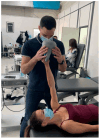Reverse Linear Neuro Periodization Model for Rehabilitation After Arthroscopic Rotator Cuff Repair: A Narrative Review
- PMID: 40558223
- PMCID: PMC12192029
- DOI: 10.3390/clinpract15060105
Reverse Linear Neuro Periodization Model for Rehabilitation After Arthroscopic Rotator Cuff Repair: A Narrative Review
Abstract
Periodization is a concept of systematic progression in training and rehabilitation. The rehabilitation literature, however, is scarce, with information about optimally designing resistance training programs based on periodization principles for injured athletes. This periodization model-reverse linear neuro periodization-is a model proposed for the long-term rehabilitation needed after an arthroscopic rotator cuff repair. With recent evidence supporting neural contributions to shoulder injuries and the rate of recovery, rehabilitation protocols may benefit from incorporating approaches that target the sensorimotor system. Integrating motor learning principles (external focus and differential learning) and new technologies (virtual reality, laser pointers, stroboscopic glasses) may bolster current shoulder rehabilitation protocols and improve patient recovery times and outcomes. Such an understanding allows well-informed sport rehabilitation specialists to better bridge the gap between the preparation for competition widely used by coaches and the treatment of injuries that may occur.
Keywords: neurocognitive; periodization; rehabilitation; rotator cuff; shoulder.
Conflict of interest statement
The authors declare no conflicts of interest. The companies or institutional affiliations involved did not influence the authenticity or objectivity of the experimental results of this work.
Figures
Similar articles
-
Outcomes of single-row and double-row arthroscopic rotator cuff repair: a systematic review.J Bone Joint Surg Am. 2010 Mar;92(3):732-42. doi: 10.2106/JBJS.I.01295. J Bone Joint Surg Am. 2010. PMID: 20194334
-
Multimedia article. The arthroscopic management of partial-thickness rotator cuff tears: a systematic review of the literature.Arthroscopy. 2011 Apr;27(4):568-80. doi: 10.1016/j.arthro.2010.09.019. Arthroscopy. 2011. PMID: 21296545
-
Prevention and management of stiffness after arthroscopic rotator cuff repair: systematic review and implications for rotator cuff healing.Arthroscopy. 2011 Jun;27(6):842-8. doi: 10.1016/j.arthro.2011.01.013. Arthroscopy. 2011. PMID: 21624680
-
Manual therapy and exercise for rotator cuff disease.Cochrane Database Syst Rev. 2016 Jun 10;2016(6):CD012224. doi: 10.1002/14651858.CD012224. Cochrane Database Syst Rev. 2016. PMID: 27283590 Free PMC article.
-
Kinesio taping for rotator cuff disease.Cochrane Database Syst Rev. 2021 Aug 8;8(8):CD012720. doi: 10.1002/14651858.CD012720.pub2. Cochrane Database Syst Rev. 2021. PMID: 34365646 Free PMC article.
References
-
- Corban J., Shah S., Ramappa A.J. Current Evidence Based Recommendations on Rehabilitation Following Arthroscopic Shoulder Surgery: Rotator Cuff, Instability, Superior Labral Pathology, and Adhesive Capsulitis. Curr. Rev. Musculoskelet. Med. 2024;17:247–257. doi: 10.1007/s12178-024-09899-7. - DOI - PMC - PubMed
Publication types
LinkOut - more resources
Full Text Sources
Miscellaneous






